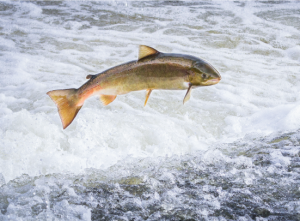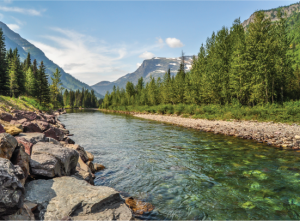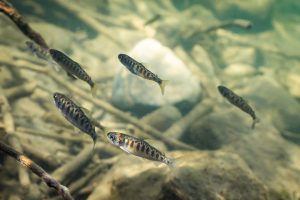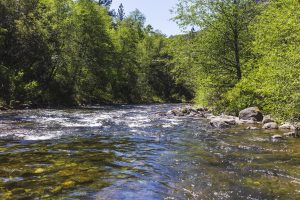


As we head into the fall, the three major runs of salmon in the Sacramento Valley have so far been strong this year, even though the conditions were very dry and hot until the recent October storms. We anticipate the recent storms and others on the horizon will provide good turbidity and conditions to further assist the remaining out-migrating salmon as they head to the ocean. In sum,
- Winter-run. There was a large adult salmon run (more than 9,500) that returned up the Sacramento River to spawn earlier this year and there are already more than 434,000 young salmon migrating downstream and many more still rearing. This is the largest return in the last 15 years and follows similar returns of 8,128 in 2019 and 7,428 in 2020.
- Spring-run, Butte Creek. The return of spring-run Chinook to the holding pools in the upper reach of Butte Creek this year was extraordinary and one of the largest runs seen in the past several decades, with estimates ranging from 15,000 to 20,000 adult fish. Despite the warm summer, there remains a substantial number of spring-run Chinook salmon in Butte Creek that are now spawning. It will be several months before spawning success and migrating numbers can be determined.
- Fall-run. We are now seeing a strong fall-run Chinook return to Battle Creek as you can see in the video from the U.S. Fish and Wildlife Service. The FWS has projected more than 30,000 adult salmon will return to Battle Creek. We will also soon see the fall-run return on the American River. This is the run of Chinook salmon that the commercial and recreational fishing industries are reliant upon.

The Myths and Facts–Sacramento Valley Salmon
Much of the reporting and hyperbole (see below) surrounding Sacramento Valley salmon population health this year has not told the complete story, as there was premature reporting and the stories have not used accurate numbers based on what biologists are seeing in the rivers.
The following describes in more detail what state and federal agencies and biologists are seeing in the different parts of the Sacramento Valley in 2021. To be sure, the dry and hot conditions in 2021 are not ideal for salmon nor any other part of the ecosystem that depends upon water and they are having challenging years. Yet, despite these dry and hot conditions, salmon are amazingly resilient and they: 1) have returned to the Sacramento Valley in record numbers; 2) will continue to spawn, and 3) are now beginning their journey down the river in large numbers. Importantly, there continues to be a concerted effort throughout the region to improve conditions for every freshwater life-cycle stage of all four runs of Chinook salmon.
Sacramento River Winter-Run Salmon
Myth: The headlines have proclaimed a “near-complete loss of young salmon,” “massive salmon die-off this summer,” “catastrophic summer salmon slaughter,” and a “California salmon wipeout.” (See hyperbole below.)
Facts: There was a large adult salmon run that returned up the Sacramento River to spawn earlier this year and there are already more than 434,000 young salmon migrating downstream and many more still rearing.
Spawning: Adult winter-run salmon migrate upstream and seek out the upper river and side channels to lay their eggs in the loose gravel that has collected below Keswick Dam. This year,
- It appears more than 9,500 adult winter-run Chinook salmon returned to the Sacramento River to spawn this year. This is the largest number of returning adults based on California Department of Fish and Wildlife (CDFW) carcass counts1 in the last 15 years and follows similar returns of 8,128 in 2019 and 7,428 in 2020.
- According to the CDFW carcass counts, approximately 75% of these in-river spawners were natural-origin winter-run Chinook (not hatchery returns).
- Fry and juvenile salmon are currently being observed utilizing rearing habitat, including side channels constructed since the last drought (see e.g., Nur Pon Side Channel video).
- This returning class is the second-generation descendants of salmon from 2015, the last very dry year when many commentators proclaimed the same complete loss of winter-run salmon.
Rearing and Early Life Stages: When the young salmon fry release from their eggs, they seek out shelter in woody debris or among rocks for protection from predators and the swift current. This allows the young fish to eat and grow as they prepare for and are now beginning their journey down river to the ocean. This year,
- More than 434,000 juvenile winter-run Chinook salmon have already (as of October 21) begun their journey downstream past the city of Red Bluff, 60 miles downstream from their spawning grounds.
- In most years, the peak out-migration is in October and November, and it is estimated that more than 500,000 juvenile winter-run Chinook will successfully migrate downstream of Red Bluff this year.
In sum, the monitoring this year is showing that there are significant numbers of salmon in the Sacramento River, even though it has been dry and hot. This reveals that the predictions for losing a whole “year class” of salmon are hyperbole and simply not accurate.

Butte Creek Spring-Run Salmon
Myth: The headlines have proclaimed that “record spring salmon run on Sacramento River tributary turns into disaster as most fish die before spawning” and “thousands of salmon washing up dead on California creek banks due to climate crisis.” (See hyperbole below.)
Facts:
- The return of spring-run Chinook to the holding pools in the upper reach of Butte Creek this year was extraordinary and one of the largest runs seen in the past several decades, with estimates ranging from 15,000 to 20,000 adult fish.
- When the salmon reached their spawning grounds in the upper creek, the holding fish were exposed to periods of high temperatures, which appeared to be lethal for some adult fish.
- There remain a substantial number of spring-run Chinook salmon in Butte Creek that are now spawning. It will be several months before spawning success and migrating numbers can be determined.
- The adult fish mortality in Butte Creek is not attributable to water management actions as the creek benefits from cold water diverted from the Feather River and the upper creek essentially functions as a natural system, with the holding pools in Butte Creek similar to the state of nature, where dry and hot years have always challenged salmon and other species.
- There is coordinated effort among conservation organizations and water suppliers, working with the state and federal fish agencies, to continue to improve passage and conditions for spring-run salmon.
- We will continue to update this information as new reporting becomes available for spring-run salmon.
Investments in Sacramento Valley Salmon
Local water management entities, conservation organizations and state and federal fisheries and water management agencies have joined together to form the Sacramento Valley Salmon Recovery Program, a collaborative partnership to complete projects and improve science to promote recovery of salmon and other species of fish in the region. These actions are implementing both the National Marine Fisheries Service’s Recovery Plan for the Sacramento River and the California Natural Resources Agency’s Sacramento Valley Salmon Resiliency Strategy. The investments in this program have significantly improved salmon conditions in the Sacramento Valley and there is more work ahead to further improve salmon conditions, knowing that salmon are and have always been challenged in dry and hot years. See Aiding Salmon in the Upper Sacramento River and the Sacramento Salmon Recovery Program for more details. If you would like to join in these efforts to improve salmon conditions in the Sacramento Valley, please contact us at info@norcalwater.org.
The Hyperbole
Sacramento River:
“’Near-complete loss’ of young salmon in Sacramento River possible, California officials say” (SF Gate, July 20,2021);
“Fears of a massive salmon die-off this summer in Sacramento River water conflict” San Francisco Chronicle, May 13, 2021;
California preps for catastrophic summer salmon slaughter” Courthouse News Service, July 27, 2021;
“Final plan for water releases into Sacramento River could kill up to 88% of endangered salmon run” San Francisco Chronicle, June 15, 2021;
“Conservationists say time running out to save endangered salmon in Sacramento River” The New York Times, July 15, 2021;
“Editorial: California salmon wipeout is even worse than you think” Los Angeles Times, July 26, 2021;
“Heat Isn’t the Only Thing That Could Kill ‘Nearly All’ Young Salmon in the Sacramento River.” Gizmodo, July 14, 2021.
Butte Creek:
“Record spring salmon run on Sacramento River tributary turns into disaster as most fish die before spawning” Sacramento News and Review, August 5, 2021;
“Thousands of salmon washing up dead on California creek banks due to climate crisis” The Independent, September 14, 2021.
Note: We are providing this information to these publications and have offered an opportunity to tour the region and see the rivers and creeks first-hand.
***If you have any questions or have additional thoughts on how to improve conditions for salmon in the Sacramento Valley, please contact us at: info@norcalwater.org.***
1California Department of Fish and Wildlife monitoring found 4,849 winter-run Chinook carcasses in the Sacramento River spawning grounds this year, which is the largest count in fifteen years. Importantly, observed carcasses are used to model and expand to an estimate of the total number of adult fish that successfully migrated to the spawning grounds. The estimated total returning fish is substantially greater than those counted. For example, in 2020, the carcass count was 3,678 fish and the final estimated return was nearly doubled to 7,428 fish and in 2019, the count of 3,026 fish was more than doubled to a final estimate of 8,128 fish. In addition, the carcass monitoring this year counted 1,588 female winter-run Chinook that had spawned before dying. This was also the largest number counted in fifteen years. (See California Department of Fish and Wildlife 2021 Winter-run Chinook Update File, “ALL YEAR SUMMARY by date” tab (available here). California Department of Fish and Wildlife “California Central Valley Chinook Population Database Report” (Grand Tab 2021.06.30); California Department of Fish and Wildlife 2021 Winter-run Chinook Update File, “Fresh spawn Female by week-year” tab (available here)***If you have any questions or have additional thoughts on how to improve conditions for salmon in the Sacramento Valley, please contact us at: info@norcalwater.org.***
Please click on the summary here for more details.




I was raised in Loomis CA where the Secret Ravine Creek runs. As a child I saw probably 100s of spawning salmon every year. Over the years with creek debris and low and warm waters the #s have dropped way off. I was at Loomis Park on King Road the other day and probably saw 30 salmon. I was a great site to see! I also hiked the other day at Hidden Falls Regional Park in Auburn the other day and saw 6 salmon in Coon Creek at the south bridge. Another nice site to see salmon make their way up to Auburn.
I walk Miners Ravine Creek off of Sierra College Blvd and have not seen any salmon in it, at least the section of trail I hike.
I have a question, do the salmon come up Dry Creek and then go up the smaller creeks? Does Dry Creek tie into the American and or Sacramento Rivers? Is that how the salmon make it up to Secret, Miners & Coon Creeks?
Well I need to no why San Joaquin river is closed over 20 years it hurts me I live here In in San Joaquin county my whole life and Can’t even salmon fish here witch is no fair to alot San Joaquin people always have to go out of the county to go salmon fishing I no places in Tracy CA. Where there’s alot of salmon at every year for 10 years I see between 1000 to 3000 salmon go there every year and I can’t even salmon fish there it sucks